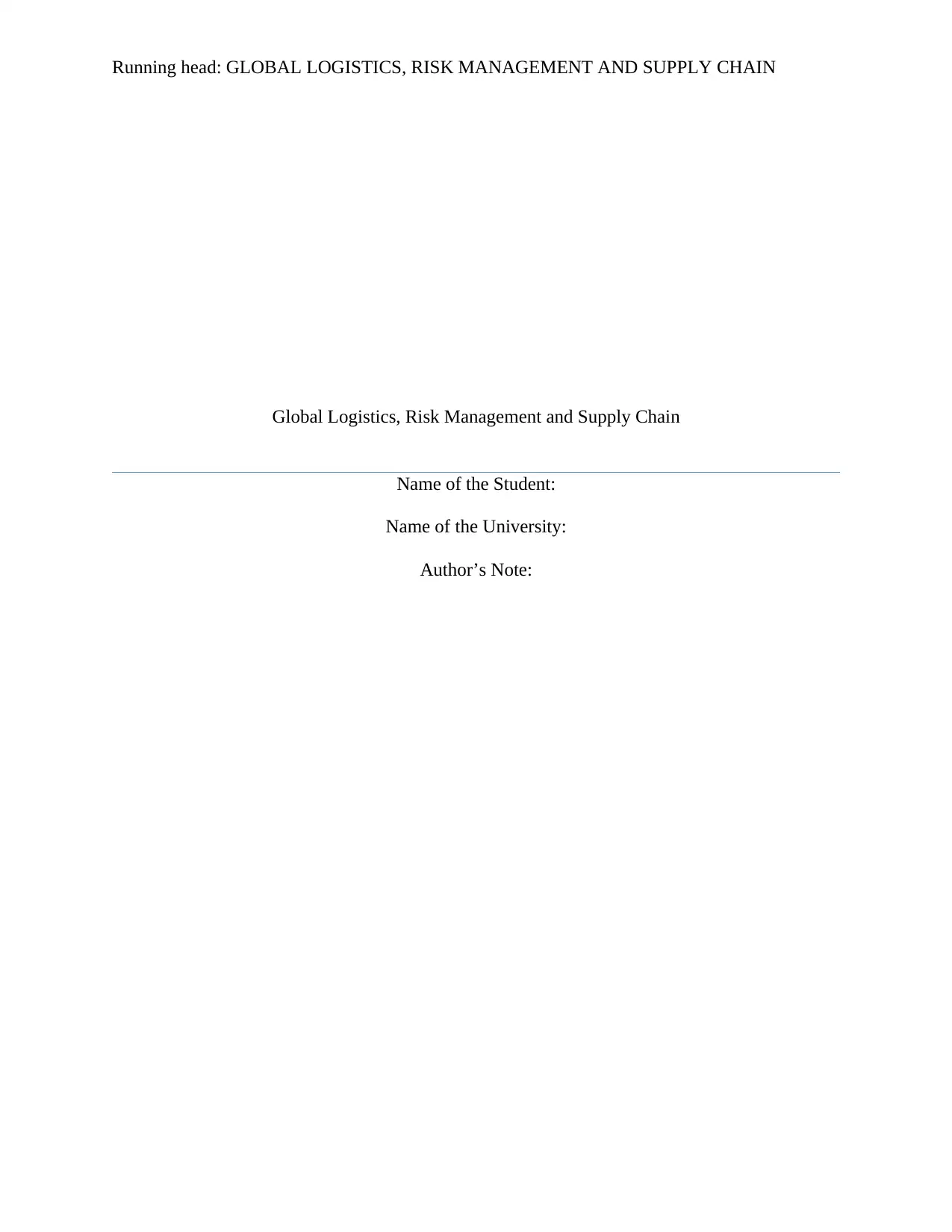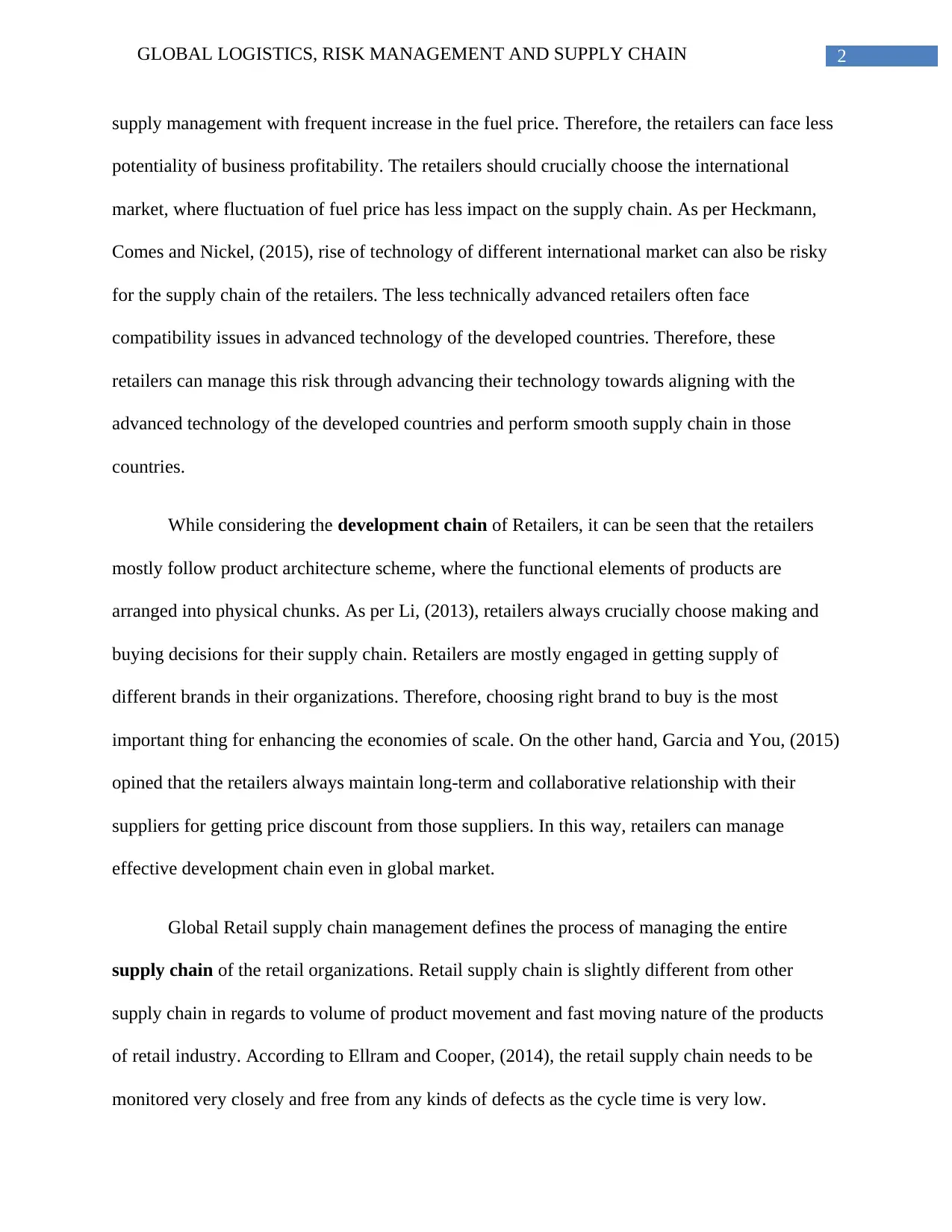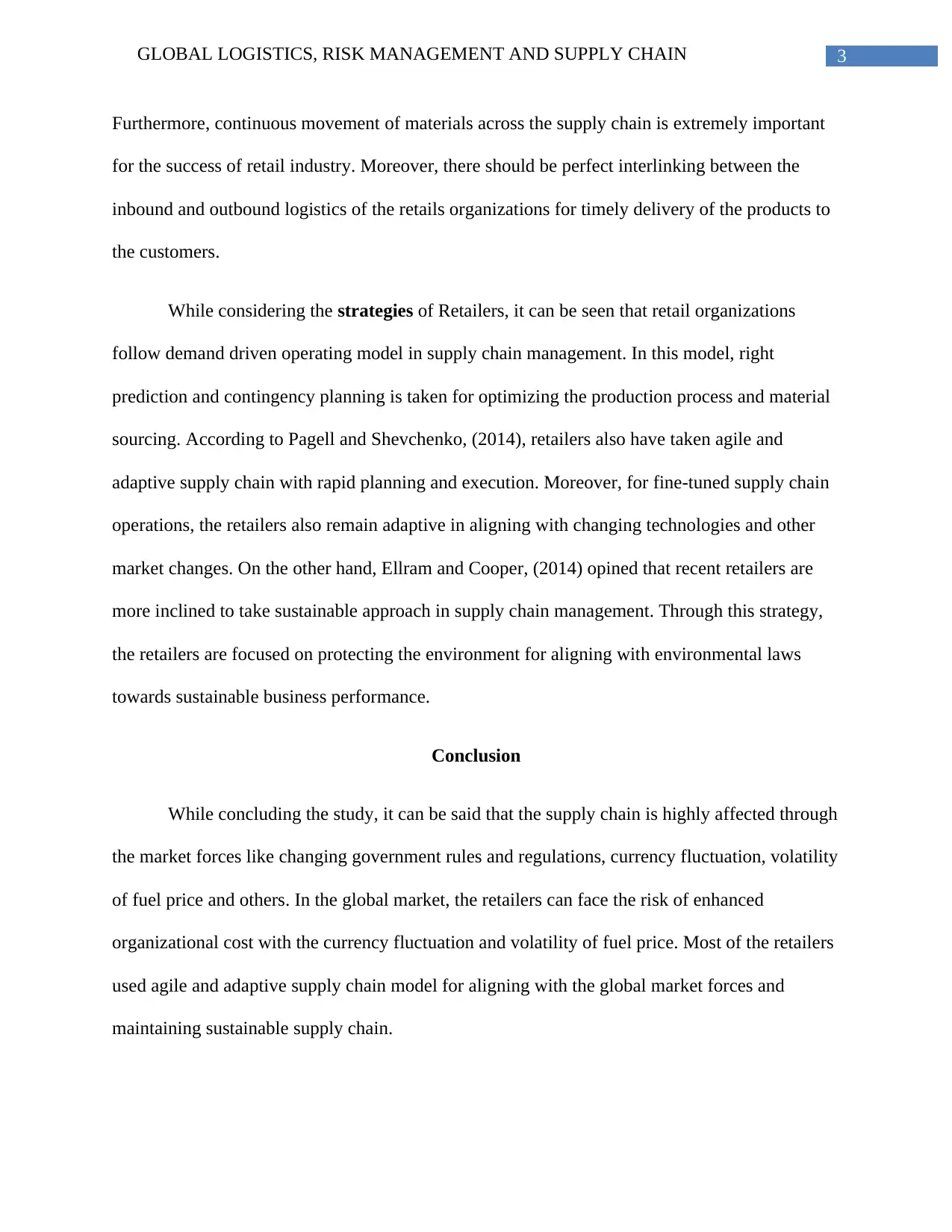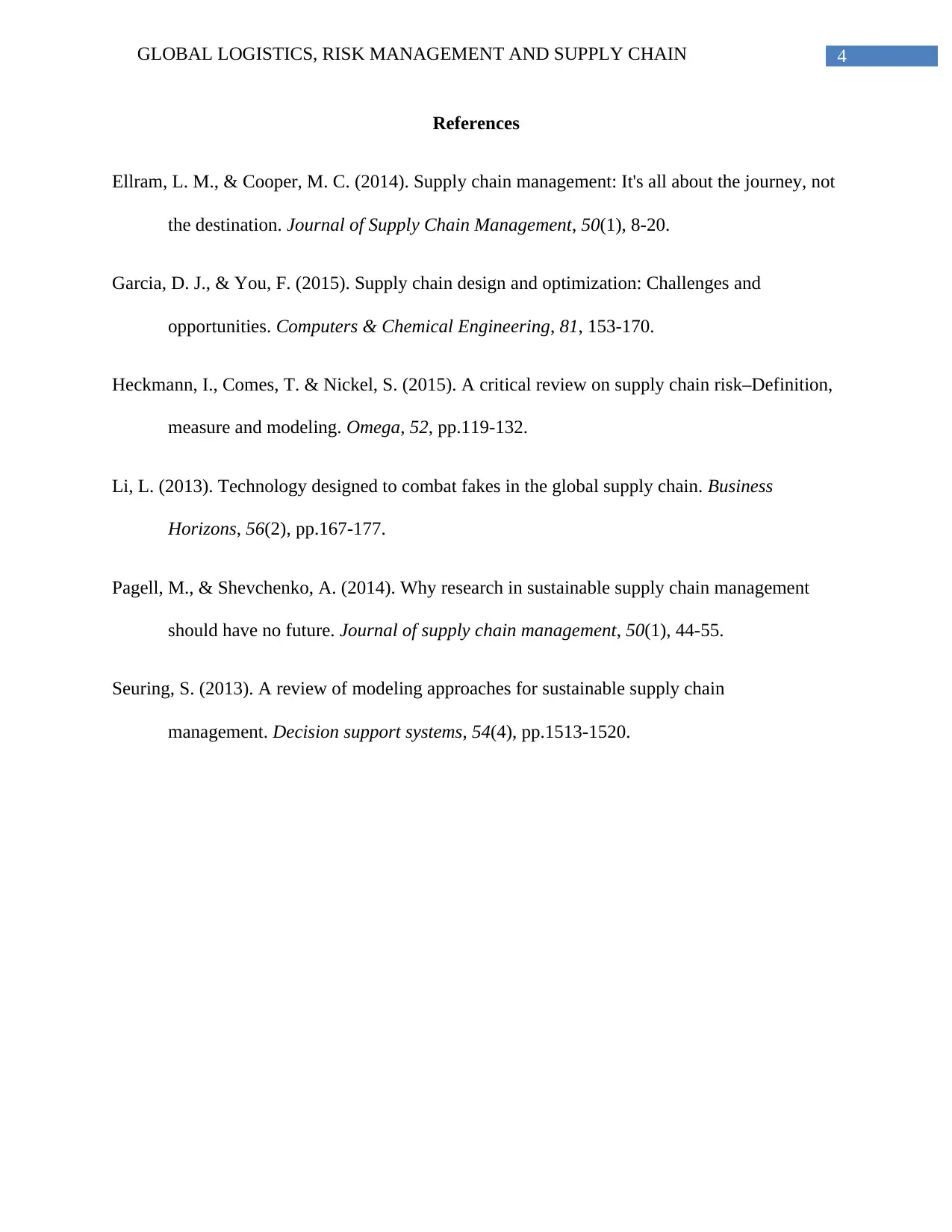Global Logistics, Risk Management, and Supply Chain: A Detailed Report
VerifiedAdded on 2020/03/13
|5
|1171
|140
Report
AI Summary
This report provides a detailed analysis of global logistics, risk management, and supply chain strategies, specifically focusing on retailers operating in the global market. The study explores the influence of global market forces, such as political instability, government regulations, volatile fuel prices, and currency fluctuations, on retail supply chains. It examines the risks associated with these forces and how they can impact business performance. Furthermore, the report discusses the development chain of retailers, including product architecture, make-or-buy decisions, and supplier relationships. It also highlights the importance of effective global retail supply chain management, emphasizing the need for close monitoring, efficient material flow, and seamless integration between inbound and outbound logistics. The report concludes by outlining various strategies employed by retailers, such as demand-driven operating models, agile and adaptive supply chains, and sustainable approaches to mitigate risks and optimize supply chain performance in the face of global challenges. The references cited further support the findings and provide additional context to the discussion.

Running head: GLOBAL LOGISTICS, RISK MANAGEMENT AND SUPPLY CHAIN
Global Logistics, Risk Management and Supply Chain
Name of the Student:
Name of the University:
Author’s Note:
Global Logistics, Risk Management and Supply Chain
Name of the Student:
Name of the University:
Author’s Note:
Paraphrase This Document
Need a fresh take? Get an instant paraphrase of this document with our AI Paraphraser

1GLOBAL LOGISTICS, RISK MANAGEMENT AND SUPPLY CHAIN
Introduction
Supply chain can be defined as the sequence of processes, which are involved in the
production and distribution of the goods. This study will choose retailers for discussion the
factors of their supply chain. In the global market, retailers are more likely to be influenced
through the global market forces. The study will discuss the global market force and risk of
supply chain of the retailers. Apart from that, the study will also discuss the development chain,
supply chain and strategies of the retailers.
Discussion
Most of the retailers are more incline to expand their business in international markets. In
such global business, retailers are to build global supply chain networks for establishing strong
supply chain networks (Pagell & Shevchenko, 2014). However, in global market, retailers face
some global market forces for their global logistic system. Political stability of different
countries can impose several restrictions on the supply chain of the retailers. Moreover, changing
government rules and regulations of the foreign Government can impact on the supply chain
management strategies. According to Seuring, (2013), volatile fuel price in the foreign market
can often impact on the cost of overall supply chain activities of the retailers. Moreover,
increasing fuel price of in the international market actually enhances the cost of the overall
supply chain network. Apart from that, Ellram and Cooper, (2014) opined that currency
fluctuation is one of the most important global market force, which have major impact on the
supply chain of retailers.
Retailers face some risks in their global supply chain, which can affect the business
performance of the retail organizations. Volatile fuel price actually increases the cost of overall
Introduction
Supply chain can be defined as the sequence of processes, which are involved in the
production and distribution of the goods. This study will choose retailers for discussion the
factors of their supply chain. In the global market, retailers are more likely to be influenced
through the global market forces. The study will discuss the global market force and risk of
supply chain of the retailers. Apart from that, the study will also discuss the development chain,
supply chain and strategies of the retailers.
Discussion
Most of the retailers are more incline to expand their business in international markets. In
such global business, retailers are to build global supply chain networks for establishing strong
supply chain networks (Pagell & Shevchenko, 2014). However, in global market, retailers face
some global market forces for their global logistic system. Political stability of different
countries can impose several restrictions on the supply chain of the retailers. Moreover, changing
government rules and regulations of the foreign Government can impact on the supply chain
management strategies. According to Seuring, (2013), volatile fuel price in the foreign market
can often impact on the cost of overall supply chain activities of the retailers. Moreover,
increasing fuel price of in the international market actually enhances the cost of the overall
supply chain network. Apart from that, Ellram and Cooper, (2014) opined that currency
fluctuation is one of the most important global market force, which have major impact on the
supply chain of retailers.
Retailers face some risks in their global supply chain, which can affect the business
performance of the retail organizations. Volatile fuel price actually increases the cost of overall

2GLOBAL LOGISTICS, RISK MANAGEMENT AND SUPPLY CHAIN
supply management with frequent increase in the fuel price. Therefore, the retailers can face less
potentiality of business profitability. The retailers should crucially choose the international
market, where fluctuation of fuel price has less impact on the supply chain. As per Heckmann,
Comes and Nickel, (2015), rise of technology of different international market can also be risky
for the supply chain of the retailers. The less technically advanced retailers often face
compatibility issues in advanced technology of the developed countries. Therefore, these
retailers can manage this risk through advancing their technology towards aligning with the
advanced technology of the developed countries and perform smooth supply chain in those
countries.
While considering the development chain of Retailers, it can be seen that the retailers
mostly follow product architecture scheme, where the functional elements of products are
arranged into physical chunks. As per Li, (2013), retailers always crucially choose making and
buying decisions for their supply chain. Retailers are mostly engaged in getting supply of
different brands in their organizations. Therefore, choosing right brand to buy is the most
important thing for enhancing the economies of scale. On the other hand, Garcia and You, (2015)
opined that the retailers always maintain long-term and collaborative relationship with their
suppliers for getting price discount from those suppliers. In this way, retailers can manage
effective development chain even in global market.
Global Retail supply chain management defines the process of managing the entire
supply chain of the retail organizations. Retail supply chain is slightly different from other
supply chain in regards to volume of product movement and fast moving nature of the products
of retail industry. According to Ellram and Cooper, (2014), the retail supply chain needs to be
monitored very closely and free from any kinds of defects as the cycle time is very low.
supply management with frequent increase in the fuel price. Therefore, the retailers can face less
potentiality of business profitability. The retailers should crucially choose the international
market, where fluctuation of fuel price has less impact on the supply chain. As per Heckmann,
Comes and Nickel, (2015), rise of technology of different international market can also be risky
for the supply chain of the retailers. The less technically advanced retailers often face
compatibility issues in advanced technology of the developed countries. Therefore, these
retailers can manage this risk through advancing their technology towards aligning with the
advanced technology of the developed countries and perform smooth supply chain in those
countries.
While considering the development chain of Retailers, it can be seen that the retailers
mostly follow product architecture scheme, where the functional elements of products are
arranged into physical chunks. As per Li, (2013), retailers always crucially choose making and
buying decisions for their supply chain. Retailers are mostly engaged in getting supply of
different brands in their organizations. Therefore, choosing right brand to buy is the most
important thing for enhancing the economies of scale. On the other hand, Garcia and You, (2015)
opined that the retailers always maintain long-term and collaborative relationship with their
suppliers for getting price discount from those suppliers. In this way, retailers can manage
effective development chain even in global market.
Global Retail supply chain management defines the process of managing the entire
supply chain of the retail organizations. Retail supply chain is slightly different from other
supply chain in regards to volume of product movement and fast moving nature of the products
of retail industry. According to Ellram and Cooper, (2014), the retail supply chain needs to be
monitored very closely and free from any kinds of defects as the cycle time is very low.
⊘ This is a preview!⊘
Do you want full access?
Subscribe today to unlock all pages.

Trusted by 1+ million students worldwide

3GLOBAL LOGISTICS, RISK MANAGEMENT AND SUPPLY CHAIN
Furthermore, continuous movement of materials across the supply chain is extremely important
for the success of retail industry. Moreover, there should be perfect interlinking between the
inbound and outbound logistics of the retails organizations for timely delivery of the products to
the customers.
While considering the strategies of Retailers, it can be seen that retail organizations
follow demand driven operating model in supply chain management. In this model, right
prediction and contingency planning is taken for optimizing the production process and material
sourcing. According to Pagell and Shevchenko, (2014), retailers also have taken agile and
adaptive supply chain with rapid planning and execution. Moreover, for fine-tuned supply chain
operations, the retailers also remain adaptive in aligning with changing technologies and other
market changes. On the other hand, Ellram and Cooper, (2014) opined that recent retailers are
more inclined to take sustainable approach in supply chain management. Through this strategy,
the retailers are focused on protecting the environment for aligning with environmental laws
towards sustainable business performance.
Conclusion
While concluding the study, it can be said that the supply chain is highly affected through
the market forces like changing government rules and regulations, currency fluctuation, volatility
of fuel price and others. In the global market, the retailers can face the risk of enhanced
organizational cost with the currency fluctuation and volatility of fuel price. Most of the retailers
used agile and adaptive supply chain model for aligning with the global market forces and
maintaining sustainable supply chain.
Furthermore, continuous movement of materials across the supply chain is extremely important
for the success of retail industry. Moreover, there should be perfect interlinking between the
inbound and outbound logistics of the retails organizations for timely delivery of the products to
the customers.
While considering the strategies of Retailers, it can be seen that retail organizations
follow demand driven operating model in supply chain management. In this model, right
prediction and contingency planning is taken for optimizing the production process and material
sourcing. According to Pagell and Shevchenko, (2014), retailers also have taken agile and
adaptive supply chain with rapid planning and execution. Moreover, for fine-tuned supply chain
operations, the retailers also remain adaptive in aligning with changing technologies and other
market changes. On the other hand, Ellram and Cooper, (2014) opined that recent retailers are
more inclined to take sustainable approach in supply chain management. Through this strategy,
the retailers are focused on protecting the environment for aligning with environmental laws
towards sustainable business performance.
Conclusion
While concluding the study, it can be said that the supply chain is highly affected through
the market forces like changing government rules and regulations, currency fluctuation, volatility
of fuel price and others. In the global market, the retailers can face the risk of enhanced
organizational cost with the currency fluctuation and volatility of fuel price. Most of the retailers
used agile and adaptive supply chain model for aligning with the global market forces and
maintaining sustainable supply chain.
Paraphrase This Document
Need a fresh take? Get an instant paraphrase of this document with our AI Paraphraser

4GLOBAL LOGISTICS, RISK MANAGEMENT AND SUPPLY CHAIN
References
Ellram, L. M., & Cooper, M. C. (2014). Supply chain management: It's all about the journey, not
the destination. Journal of Supply Chain Management, 50(1), 8-20.
Garcia, D. J., & You, F. (2015). Supply chain design and optimization: Challenges and
opportunities. Computers & Chemical Engineering, 81, 153-170.
Heckmann, I., Comes, T. & Nickel, S. (2015). A critical review on supply chain risk–Definition,
measure and modeling. Omega, 52, pp.119-132.
Li, L. (2013). Technology designed to combat fakes in the global supply chain. Business
Horizons, 56(2), pp.167-177.
Pagell, M., & Shevchenko, A. (2014). Why research in sustainable supply chain management
should have no future. Journal of supply chain management, 50(1), 44-55.
Seuring, S. (2013). A review of modeling approaches for sustainable supply chain
management. Decision support systems, 54(4), pp.1513-1520.
References
Ellram, L. M., & Cooper, M. C. (2014). Supply chain management: It's all about the journey, not
the destination. Journal of Supply Chain Management, 50(1), 8-20.
Garcia, D. J., & You, F. (2015). Supply chain design and optimization: Challenges and
opportunities. Computers & Chemical Engineering, 81, 153-170.
Heckmann, I., Comes, T. & Nickel, S. (2015). A critical review on supply chain risk–Definition,
measure and modeling. Omega, 52, pp.119-132.
Li, L. (2013). Technology designed to combat fakes in the global supply chain. Business
Horizons, 56(2), pp.167-177.
Pagell, M., & Shevchenko, A. (2014). Why research in sustainable supply chain management
should have no future. Journal of supply chain management, 50(1), 44-55.
Seuring, S. (2013). A review of modeling approaches for sustainable supply chain
management. Decision support systems, 54(4), pp.1513-1520.
1 out of 5
Related Documents
Your All-in-One AI-Powered Toolkit for Academic Success.
+13062052269
info@desklib.com
Available 24*7 on WhatsApp / Email
![[object Object]](/_next/static/media/star-bottom.7253800d.svg)
Unlock your academic potential
Copyright © 2020–2025 A2Z Services. All Rights Reserved. Developed and managed by ZUCOL.





